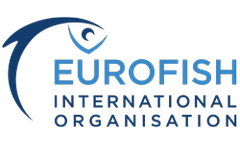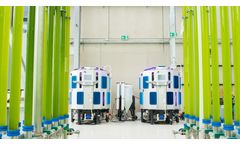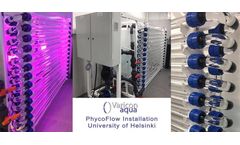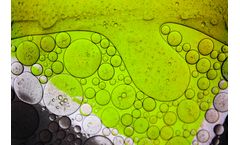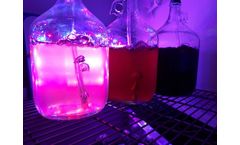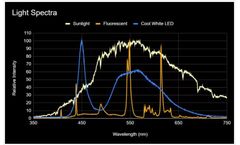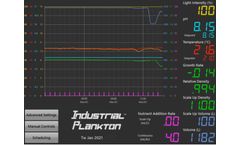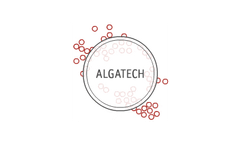Microalgae Cultivation Articles & Analysis
33 articles found
Seeking a revolution in freshwater aquaculture This article was featured in Eurofish Magazine 3 2024 SmartAqua4FuturE (SAFE) is an ambitious project funded by Horizon Europe that aims to revolutionise freshwater aquaculture. The project seeks to make freshwater aquaculture more environmentally friendly while increasing its financial stability by introducing circular economy approaches. The ...
ByEurofish
However, the efficiency of these systems hinges on a critical factor: the inoculum/pre-culture of uncontaminated, high-quality algae to kickstart production, and a lot of reliable inoculum is required to keep these systems running.The Challenges of Traditional Cultivation Traditional methods, specifically using laboratory processes (flask and carboy culture), present a challenge ...
Researchers will use the tubular photobioreactor, situated on the Lahti campus (Faculty of Biological and Environmental Sciences), to cultivate microalgae in support of their on-going projects. One such project, Algae Factory, funded by Business Finland, focuses on producing microalgal biomass using nutrient rich side streams. The project targets production of ...
We are pleased to announce the latest installation of a 2750 L Phyco-Flow system for Grupo Fagro at their new Micro Algae Technology Development Unit, Biorganix in Ramos Arizpe, Mexico in conjunction with Novel Agricultural Bioactives from Microalgae (NAMBA) initiative. Our Phyco-Flow tubular photo-bioreactor will be used to cultivate microalgae ...
Varicon Aqua’s latest project is up and running in Hong Kong, with the installation led in person by our Managing Director, Joe McDonald. The client, Geb Impact Technology Company Limited, will be using two of our reactor systems, the Phyco-Lift and the Phyco-Pyxis, the latest in our range of innovative products. Geb Impact and Varicon Aqua have enjoyed a long professional relationship, ...
We are delighted to have completed our latest 12,000 L Phyco-Flow photobioreactor installation for Algaecytes UK. This Phyco-Flow is the most recent example of our multi photo-stage photobioreactor, designed specifically for industrial scale production of microalgae. The system incorporates full process control, with data acquisition and remote access alongside integration of upstream and ...
Algae produce about 70% of the oxygen in the atmosphere, and they can be mainly classified as microalgae and macroalgae. What Can Algae Do? Single-celled microscopic algae are called microalgae and multicellular filamentous, membranous, tubular, or foliar plants are called macroalgae, which are autotrophic oxygen-releasing plants. ...
Microalgae Growth – Light Intensity If light is one of the key ingredients in photosynthesis, will more light always generate more productivity? Not exactly. Microalgae growth tends to have a consistent relationship with light intensity. Though the actual growth rates and intensities for different points in this curve will vary depending on many factors the general shape is consistent ...
Microalgae need light to grow and photosynthesize, but not all light is created equal. The spectrum of light can have a big impact on how well your algae grows. The spectrum of a light is how bright it is at different wavelengths. This can be closely related to colour, e.g. a red LED looks red because it is emitting light with a wavelength of 650 nm. However, differences in light spectra can ...
Growing microalgae can seem complicated because there are so many factors that need to be just right for a successful algae culture. In this article we are going to briefly explain some of these factors and why they are important. Microalgae are an evolutionarily diverse group of organisms that come in many colours and shapes. They are united by their small size (1 – 100 µm for ...
Algae are not new in the aquaculture sector. In fact, algae are in many cases indispensable for the success of the aquaculture industry. The biggest hurdles for inhouse algae production in the aquaculture industry are the high costs, the labour intensiveness, and the complexity of maintaining healthy algae cultures. Traditionally, hatcheries have been using big plastic bag type systems and bubble ...
Algatech, a global innovative leader in the development, cultivation and commercialisation of microalgae-derived ingredients, has licensed the rights and intellectual property related to the production of p-1,3-glucan from microalgae Euglena gracilis from US biotechnology company F3 Platform Biologies ("F3"). ...
ByAlgatech
For the Biome, the revolutionary new wellness company launched by Paul Schulick, founder of the iconic nutritional supplement company New Chapter, has announced a partnership with microalgae innovator Algatech on topical applications. Based in Israel's Arava desert, Algatech is known for developing cutting-edge products including AstaPure®Astaxanthin, a premium natural ...
ByAlgatech
Aquaculture has increased its market share to 50% of global seafood production, and species cultivated have changed, making its relationship with freshwater resources more significant. ...
We are currently cultivation microalgae species such as Haematococcus Pluvialis and Auxenochlorella protothecoides. Please read more about these microalgaes in our product page for the BioAlgae-unit. Our goal is to produce microalgaes for new valuable food products, such as fish- and animal feed ingredients or as ...
Redono is performing hydroponic plant cultivation and microalgae cultivation researches together with the Clean Technologies Department in Metropolia, University of Applied Science, Vantaa. ...
This work evaluates the use of native microalgae consortia for a dual role: polishing treatment of municipal wastewater effluents and microalgae biomass feedstock potential for biodiesel or biofertilizer production. An initial screening was undertaken to test N and P removal from secondary effluents and biomass production by 12 consortia. A subsequent treatment was performed by selected ...
BUCHI Mini Spray Dryer B-290: Yield and total yield determination in spray dried microalgaes Recently, microalgal biomass has been recognized as a promising alternative source of raw material for biofuel production. Algal biomass has several advantages that may help to meet the need for the global demand of transport fuels, such as rapid growth rate, high lipid content, small ...
ByBUCHI
The bioprospecting of potentially mixotrophic microalgae in a constructed wetland was conducted. A locally isolated microalga, Chlorella sp., was grown to determine the effect of temperature, aeration rate, and cultivation time on simultaneous biomass production and nutrient removal from piggery wastewater using central composite design ...
The effect of chemical coagulation and biological auto-flocculation relative to zeta potential was examined to compare flotation and sedimentation separation processes for algae harvesting. Experiments revealed that microalgae separation is related to auto-flocculation of Anabaena spp. and requires chemical coagulation for the whole period of microalgae ...

